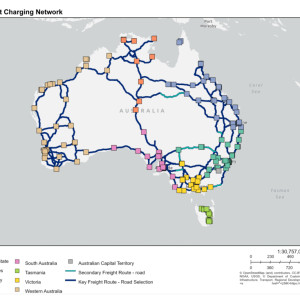Electrifying Road Freight: Australia’s Blueprint for a Cleaner Transport Future

Australia's first national blueprint for battery-electric freight transition is here. Australia's road freight industry is an economic powerhouse, contributing 8.6% of our national GDP. However, this sector alone accounts for around one third of Australia's total transport emissions.
As freight is expected to grow by 77% by 2052, electrifying this sector is critical in Australia's pursuit of net zero emissions. A new landmark report aims to address this challenge, offering the nation's first comprehensive blueprint for decarbonising the sector. With input from over 35 stakeholders over a 12 month period, the Electrifying Road Freight: Pathways to Transition report[1] outlines the energy, infrastructure, and policy shifts needed to transition heavy vehicles to battery-electric power.
Commissioned by ARENA and delivered by infrastructure engineering consulting firm AECOM, the report is a call to action for the entire industry to work together to build a cleaner, more efficient freight future.
Unpacking the freight landscape
Freight in Australia is as diverse as the terrain it covers. From dense urban corridors to remote regional highways, the use cases for freight vehicles vary widely, and so do the challenges and opportunities for electrification. Urban freight is typically characterised by short-haul deliveries, depot-based operations, and predictable daily routes.
Battery electric trucks can be charged overnight at depots, and their range is well-suited to city logistics. This segment includes parcel delivery services, supermarket distribution, and waste collection - sectors already trialling or adopting electric vehicles. Intrastate freight involves longer distances and less predictable schedules.
Trucks may travel hundreds of kilometres between towns, often with limited access to charging infrastructure. Interstate freight presents the most complex use case. These vehicles operate across interstate corridors, often running continuously with multiple drivers.
Intrastate and interstate charging solutions are typically a mix of depots and hubs and on-road. Overlaying these use cases is the structure of the industry itself. More than 90% of freight businesses in Australia are small operators.
These businesses often lack the capital to invest in new technology and often rely on second-hand, or even third-hand, vehicles. Supporting their transition will require tailored financial models, shared charging infrastructure, and clear regulatory guidance.
Key report findings
Australia will need up to 165 heavy vehicle charging hubs
The report outlines a first of kind national overview of a future electrified freight network, with up to 165 future freight charging hubs collocated with existing port, road, and intermodal infrastructure. However, further localised planning will be essential to determine optimal sites on a micro scale.
Energy generation is not going to be a challenge - transmission and distribution will
While additional energy generation is needed, current forecasts indicate that the needs of the sector will be met.
However, insufficient transmission and distribution infrastructure pose a more serious challenge to the future of freight electrification - particularly in supporting interstate and intrastate freight rollouts.
Urban freight is ready for electrification
Smaller vehicles, shorter distances, and depot and home-based operations make urban freight the most viable starting point - and it is electrification-ready. Intrastate and interstate freight will require staged infrastructure and planning.
Cost and complexity are key barriers
Battery electric trucks remain cost-prohibitive for the small operators, which make up 98% of the sector. Regulatory settings and licensing frameworks need to be reviewed to facilitate the transition.
Megawatt scale charging is important
To enable long-haul green freight corridors, early investigation and investment in local MW-scale charging solutions will improve infrastructure speeds to meet heavy vehicle duty cycle demands. Overseas, systems up to 3.75 MW are already being tested.
Policy, investment, and delivery must be aligned
Coordinated action across policy, industry, and network providers is essential.
Demonstrating what's possible
 ARENA provided over £12.8 million to an ANC Project to deploy 112 BEVs and install chargers for use in Last Mile Delivery across Australia.
ARENA provided over £12.8 million to an ANC Project to deploy 112 BEVs and install chargers for use in Last Mile Delivery across Australia.
ARENA is backing some of Australia's most ambitious electric freight trials to test vehicle performance, charging needs, and grid impacts in real-world conditions.
These include:
- Patrick Terminals[3]: 9 electric terminal trucks and fast chargers at its Fremantle Port
- Linfox: 26 electric trucks and 25 chargers across three states, serving a range of metropolitan and regional routes
- Toll Group[5]: 28 electric trucks and 31 chargers at 10 sites nationwide
- Zenobe[6]: 60 electric trucks and a charging hub near Mascot NSW, hosting 22 dual-plug chargers and a second-life stationary battery
These projects are helping to de-risk investment, validate new technologies, and build operational know-how across the freight sector.
What's next?
The report outlines 21 recommendations, from regulatory reform and data collection to funding pilots and supporting local manufacturing. It now provides an opportunity to engage more deeply with all partners in the freight transition to move national insights into regionally actionable plans. This is a pivotal moment for Australia's freight sector.
With the right investment, coordination, and ambition, we can electrify the backbone of our economy - and cut emissions while we're at it.
Read the full Electrifying Road Freight Report.[7]
References
- ^ Electrifying Road Freight: Pathways to Transition report (arena.gov.au)
- ^ Centurion (arena.gov.au)
- ^ Patrick Terminals (arena.gov.au)
- ^ ANC (arena.gov.au)
- ^ Toll Group (arena.gov.au)
- ^ Zenobe (arena.gov.au)
- ^ Electrifying Road Freight Report. (arena.gov.au)
